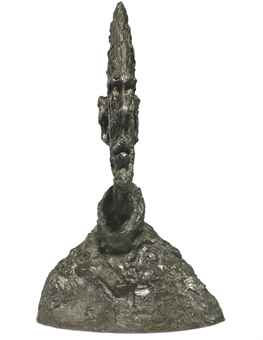 This weekend, we visited Pook & Pook Auction in Downingtown, PA and Rago's in Lambertville, NJ.
This weekend, we visited Pook & Pook Auction in Downingtown, PA and Rago's in Lambertville, NJ. In many ways, these two venues represent polar opposites of the auction market in terms of product offerings.
Pook's Saturday sale featured about 750 lots of 18th and 19th century American furniture and decorative arts. The room was filled with buyers; the phones were busy and the internet bought some items. Almost nothing was passed. Prices for beautiful pieces of finely made antique furniture and tall case clocks seemed sadly low. Competition was stiff, however, for the best examples of paintings,
pen wipes (who knew?), quilts, miniatures and anything rare and unusual. The
John George Brown (American, 1831-1913) oil painting
The Monopolist, hammered down for $115,000 (plus 18.5% buyers premium) on a $35,000-55,000 estimate.
 Rago's Saturday sale
Rago's Saturday sale consisted of over 1000 lots of 20th and 21st century furniture and dec art. There appeared to be more workers
in the room than buyers. The phones and internet were active. Modern furniture by known makers such as
Nakashima, Springer, LaVerne, Parzinger, Evans and Robsjohn-Gibbings were popular.
A Victor Schreckengost Jazz Bowl hammered down for the same price as the JG Brown painting at Pook's, plus Rago's 22% buyer's premium. David's estimate was $20-30,000. David presented quite a few "experiments;" decorations by offbeat or unknown artists. There were a lot of items passed or bought in.
Many an antique collector has lamented that "they just don't make 'em like they used to." 21st century buyers are proving to be savvy, as well. Fine furniture and art have been and are still being made today. It appears that
modern furniture by well-known makers seems to be selling better than antique. Decorations that are
cool or rare are selling regardless of their age.
 The Antiques Roadshow website has a game you can play. You watch a little video segment. Along the way are multiple choice questions regarding the item (like "Who is Thomas Chippendale?") And finally, can you guess the price before the appraiser calls it?
Thanks to 16 years of fine and decorative art study, I managed the multiple choice questions pretty well. The appraised values, however, weren't quite so easy. My timing was off. The objective is to "beat the appraiser." I contend that the roadshow appraiser knows so much more about the item, having researched the bejesus out of it, there's no way I can beat him. Drew's better at this than I am.
This brings me to the BIG Antiques Roadshow FALLACY. The Roadshow Appraiser not only sees the item before he goes on television, he has the benefit of exhaustive research, executed by a team of appraisers with computers, libraries, sales results, and everything there is to know about the item including history and provenance. Sometimes AR knows about a piece before they even get into town!
The Antiques Roadshow website has a game you can play. You watch a little video segment. Along the way are multiple choice questions regarding the item (like "Who is Thomas Chippendale?") And finally, can you guess the price before the appraiser calls it?
Thanks to 16 years of fine and decorative art study, I managed the multiple choice questions pretty well. The appraised values, however, weren't quite so easy. My timing was off. The objective is to "beat the appraiser." I contend that the roadshow appraiser knows so much more about the item, having researched the bejesus out of it, there's no way I can beat him. Drew's better at this than I am.
This brings me to the BIG Antiques Roadshow FALLACY. The Roadshow Appraiser not only sees the item before he goes on television, he has the benefit of exhaustive research, executed by a team of appraisers with computers, libraries, sales results, and everything there is to know about the item including history and provenance. Sometimes AR knows about a piece before they even get into town!
 indeed, as well as the ability to recall the data and use their lips
indeed, as well as the ability to recall the data and use their lips




















